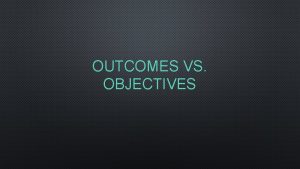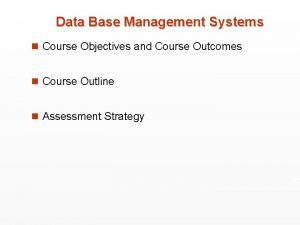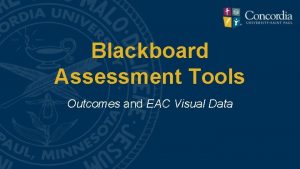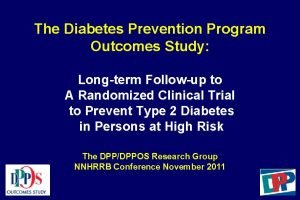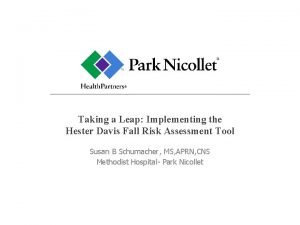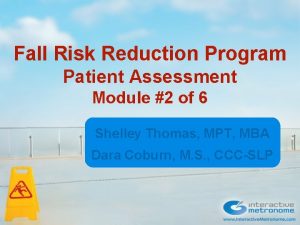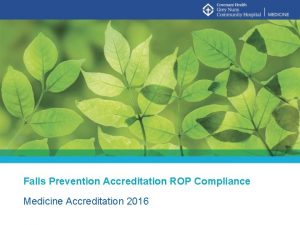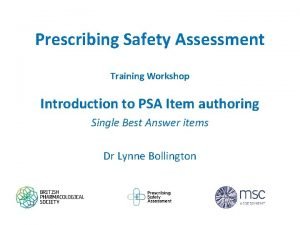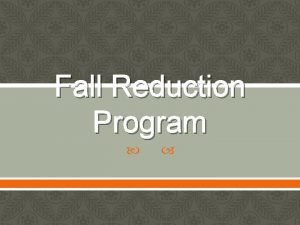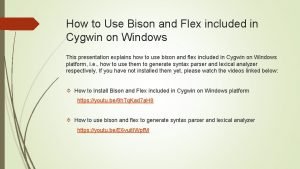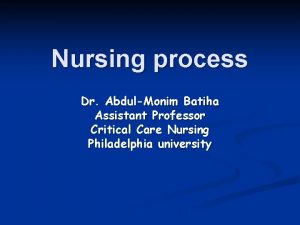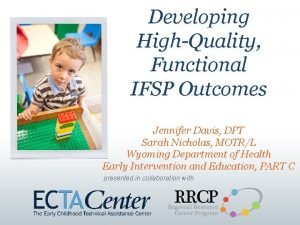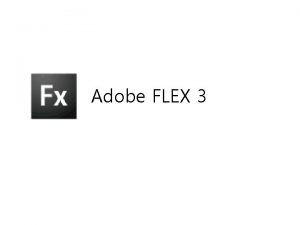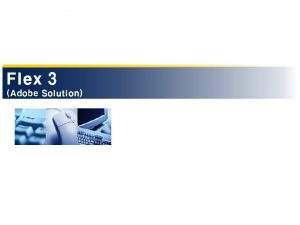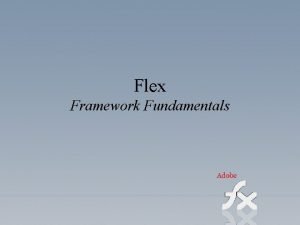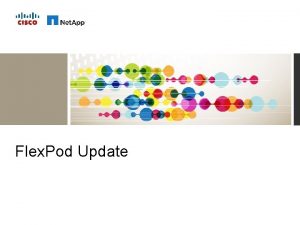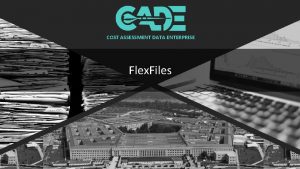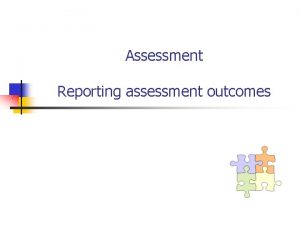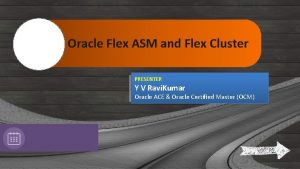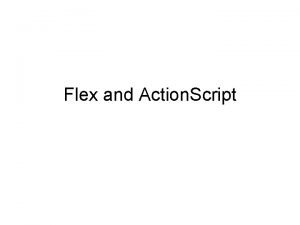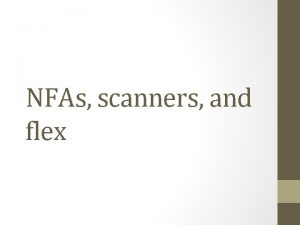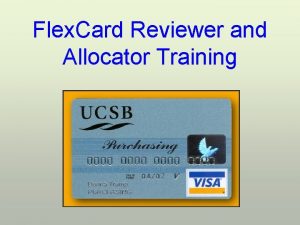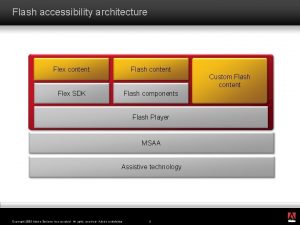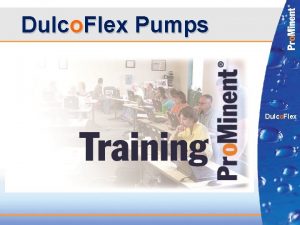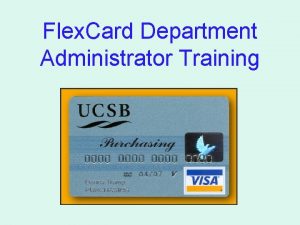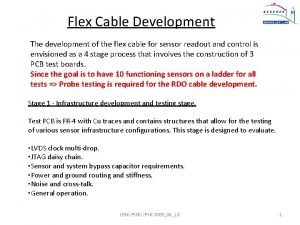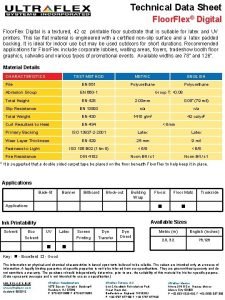Assessment of Course and Program Outcomes Fall Flex





















- Slides: 21

Assessment of Course and Program Outcomes Fall Flex Workshop August 17, 2017 Joanne Benschop (SLO Coordinator) John Thomford (Outcomes Assessment Committee faculty co-chair)

Learning Outcomes Development Courses and Programs Think SMART Specific Measurable Attainable Realistic Time-Bound

Guidelines for Program Outcomes. Utilizing Bloom’s Taxonomy of Action Verbs

Guidelines for Creating Program Outcomes. Direct Program Outcomes. Indirect Specific knowledge and skills you expect students to acquire as part of their educational experience in the program Knowing, thinking, understanding, or appreciating is invisible and cannot be directly observed Focused on demonstrable behaviors Focused on student perception of academic experience

Guidelines for Creating Program Outcomes Preliminary Steps Define the mission or goal of the program Program goal related to College’s Mission Secondary Steps Focus on foundational courses within the program Focus on capstone expectations Focus on areas of concentration or emphasis within a program Focus on relationship to academic discipline Focus on observable skills

Program Outcome- Directly related to Academic Discipline General Graduates of the Criminal Justice program will be critical thinkers Program Specific Graduates of the Criminal Justice program will be able to analyze a current issue in criminal justice, evaluate evidence, and construct an argument

Direct PSLO Assessments demonstrate observable abilities Not Observable Graduates of the BA program will think critically. Graduates of the AA program will interpret, analyze, evaluate and construct arguments Setting up an outcome in this manner also sets the evaluation criteria for your evaluation rubric!

Program Outcomes-Communicate a Single Outcome Multiple Outcomes Graduates of the psychology program will be lifelong learners who understand the concepts of psychology and can apply those concepts to the design and application of real research problems. Single Outcome Graduates of the Psychology program will be able to design a research study.

Communicate A Single Outcome “Students completing the BS in mathematics should be able to analyze and interpret data to produce meaningful conclusions and recommendations and explain statistics in writing”.

No Capstone Course? Identify the Core courses in your program Review the SLO’s for each of these courses Determine the most important SLO for each course Synthesize those outcomes into PLO’s

Synthesizing Course SLO’s & Linking to PSLOs Program SLO’s Required C. O. R. CSLO’s Students will be able to analyze the characteristics of interactions between two people. Students will be able to analyze various group membership roles to determine which roles helped or hindered the group meet its goals ü The student will understand the relevance of theories and methods of communication The student will be able to define The student will be able specific social concepts as they to define specific social pertain to the operation of social concepts as they pertain institutions to the operation of social institutions The student will be able to analyze research data (e. g. SPSS, Analyze research data Excel) and communicate research findings

Program Learning Outcomes Checklist ü Can be directly measured and learned ü Maps to curriculum ü Relies on action verbs in future tense ü Should be simple and not compound ü Are useful to identify areas to improve ü Describes what students are intended to do, know or produce

Two Parts to SLO’s Outcome Statements of overarching knowledge, skills, abilities, or attitudes that students should acquire in a program. Assessment Determine how well learning expectations are being met. What students will know, be able to do, or be able to demonstrate when they have completed the course. Means of assessment are connected to the SLOs

Program SLO Assessment Methods Direct Assessment Methods Indirect Assessment methods Ask students to demonstrate learning Measure students’ perception of their experience in a program Embedded assessments Standardized tests Surveys Portfolios Focus Groups Capstone course or Final Project/Presentation Exit Interviews Reflective essays Derived from University of Connecticut’s SLO website

Guidelines for Selecting Assessment Methods Collect information that will answer the program’s questions Use multiple methods to assess each student learning outcome Include both indirect and direct assessment methods Include both qualitative and quantitative methods Choose methods that allow the assessment of both strengths and weaknesses Utilize capstone courses or “second-year” projects/assignments to directly assess student learning outcomes

When should assessments be performed? Course: Required-6 year cycle Program: Required 6 year cycle Considerations: Is assessment occurring to actually improve student learning and classroom teaching? Level of course Frequency of course offering Opportunities to collect and analyze data as a faculty group

Evaluation of assessments Method: Rubrics A scoring guide that describes criteria to evaluate student work: Performances, presentations, papers, journals, artwork, etc Strengths: Helps to precisely define faculty expectations Assists students in clarity on how they will be graded Describe what students will do to demonstrate their learning (criteria) Possible levels of achievement (standards)

Reporting/Documenting Trac. Dat is the storehouse database for all evaluations of SLOs. https: //tracdat. miracosta. edu/tracdat/

Closing the Loop Learning Outcome • • Expectations: what we expect students to know, do, and be when they leave a course, program or institution. Results: The knowledge, abilities, and/or attitudes students demonstrably possess at the conclusion of a learning experience. 5) Interpret results, identify, and implement revisions to pedagogy, curriculum, programs, criteria or outcomes. 4) Collect, review and analyze evidence of student learning 1) Design Assessment: Goals, outcomes, evidence, criteria and standards (ex. rubrics) 2) Publicly share outcomes, criteria and standards 3) Provide intentional learning experiences (curriculum & pedagogy) Based on Driscoll & Wood, 2007

FAQ’s – We will try to answer How do certificate and degree program SLOs differ? What if I don’t have a Program SLO because my department does not offer a degree/certificate? What is mapping of SLOs? Your Questions? ? ?

Sources www. asu. edu/oue/outcomes. html Mage, R. E. (1997). Making instruction work or skillbloomers: A step-by-step guide to designing and developing instruction that works, (2 nd ed. ). Atlanta, GA: The Center for Effective Performance, Inc. Mager, R. E. (1997). Preparing instructional objectives: A critical tool in the development of effective instruction, (3 rd ed. ). Atlanta, GA: The Center for Effective Performance, Inc. Pohl, Michael. (2000). Learning to think, thinking to learn: Models and strategies to develop a classroom culture of thinking. Cheltenham, Vic. : Hawker Brownlow. Tarlinton (2003). Bloom’s revised taxonomy. http: //www. kurwongbss. qld. edu. au/thinking/Bloom/bloomspres. ppt. University of Illinois, Center for Teaching Excellence (2006). Bloom’s taxonomy. www. oir. uiuc. edu/Did/docs/QUESTION/quest 1. htm
 Course outcomes vs objectives
Course outcomes vs objectives Course objectives of database management systems
Course objectives of database management systems Blackboard outcomes assessment
Blackboard outcomes assessment Program specific outcomes nba
Program specific outcomes nba Diabetes prevention program outcomes study
Diabetes prevention program outcomes study Course number and title
Course number and title Half brick wall in stretcher bond
Half brick wall in stretcher bond Course interne moyenne externe
Course interne moyenne externe Hester davis fall assessment
Hester davis fall assessment Fall risk assessment tool
Fall risk assessment tool Splatt fall assessment
Splatt fall assessment Splatt falls
Splatt falls Prescribing safety assessment course
Prescribing safety assessment course Fall reduction program
Fall reduction program How to use bison
How to use bison Order of the nursing process
Order of the nursing process Planning goals and learning outcomes
Planning goals and learning outcomes Collaborative interventions nursing
Collaborative interventions nursing Direct and indirect speech objectives
Direct and indirect speech objectives Modern input devices
Modern input devices Examples of ifsp outcomes and strategies
Examples of ifsp outcomes and strategies Learning outcomes of work and energy
Learning outcomes of work and energy
